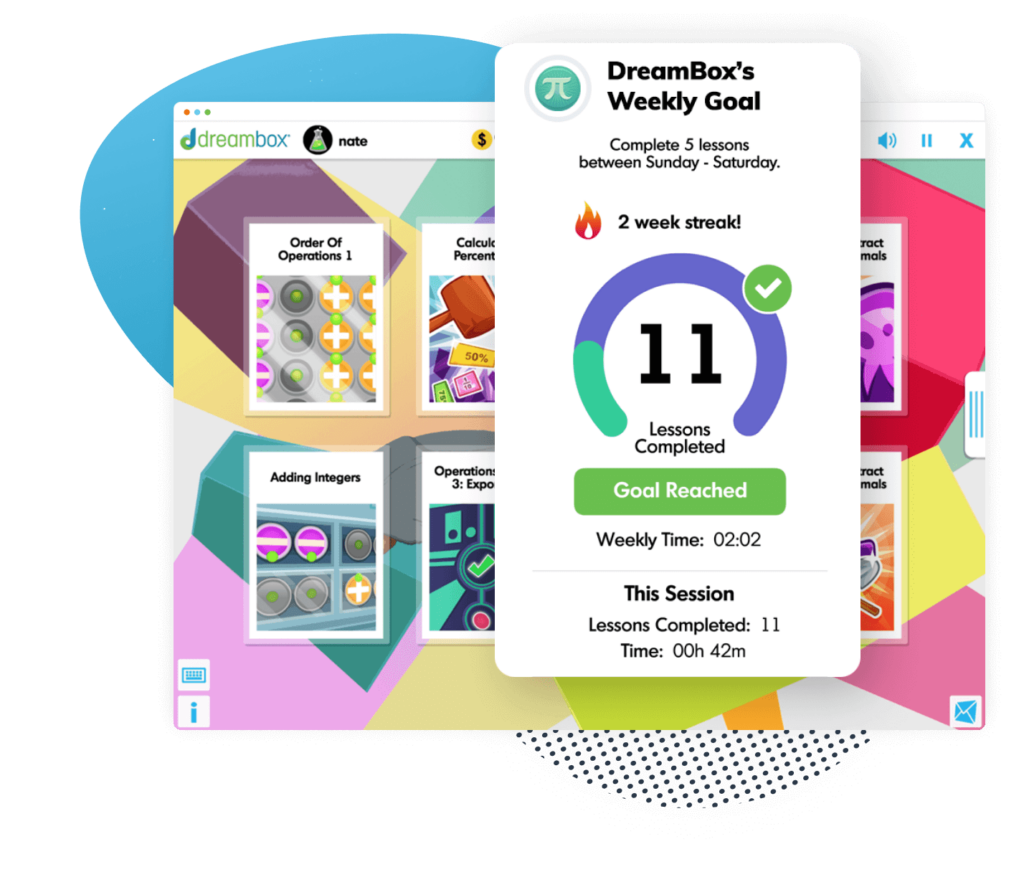Common Core Kindergarten Math Standards
The Common Core Math Standards outline the skills that K-12 students in the US should have mastered by the end of each school year. Let’s look at the kindergarten common core math standards.

Author
Katie Wickliff
Published:
Oct 2024
Key takeaways
- • The purpose of the Common Core is to provide standardized learning goals for students across the United States.
- • Kindergarten math Common Core standards cover five areas: counting and cardinality, operations and algebraic thinking, number and operations in Base 10, measurement and data, and geometry.
- • Not all states and schools follow the common core, so kindergarten math standards can vary.
The beginning of kindergarten is an exciting and memorable time for many families. Kindergarten is the launch point of K-12 education, and many parents of kindergarteners must navigate an entirely new environment.
In 2010, the government introduced the Common Core State Standards Initiative to establish a streamlined education system in the United States. These standards specify the concepts in mathematics and English/Language Arts that kindergarten through 12th grade students should learn each school year.
Although the Common Core Initiative aims for uniformity in kindergarten math standards, these standards vary by state and school. Although most states have adopted the Common Core, others have decided not to participate, adapted the standards, or withdrew entirely. Independent and parochial schools that do not receive government funding are not mandated to implement the Common Core. However, many of these private institutions still follow certain aspects of the program.
If your kindergartener attends a school that follows Common Core Math standards, but you’re unfamiliar with the initiative, read on. This article will clarify what Common Core is and provide an overview of kindergarten common core math standards for students across the United States. Since practicing math skills at home is so important, we’ll also help you make it fun for your kindergartener.
If you want to understand the details of Common Core kindergarten math, we’re here to help.
Table of contents
Kindergarten Math Common Core Standards
The common core kindergarten math standards address five main topics: counting and cardinality, operations and algebraic thinking, number and operations in Base 10, measurement and data, and geometry.
Counting and Cardinality
Kindergarten students learn to count to 100 by ones and by tens. They also learn to begin at a number other than one and count from that point.
Kindergarteners will write numbers from 0-20 and begin to notice the relationship between numbers and quantities.
Cardinality is the idea that the final number of the sequence represents the quantity of objects counted, and kindergarteners will develop this ability to answer a “how many?” question with a number.
Using matching and counting strategies, kindergarten students will determine if the number of objects in one group is greater than, less than, or equal to the number of objects in a second group.
Kindergarten Math Resources
See how DreamBox can help your kindergartener with math.
Operations and Algebraic Thinking
In kindergarten, students learn that addition involves combining numbers or adding to them, while subtraction involves breaking down numbers or taking from them.
Kindergarteners will learn to fluently add and subtract within 5 and use objects or drawings to solve addition and subtraction word problems within 10. They will learn strategies to decompose numbers into pairs in more than one way: for example: 6+1=7 and 5+2=7.
Number and Operations in Base 10
Base 10 is a number system that uses ten digits (0-9) to represent any number. In kindergarten, students will begin to understand place value by working with numbers 11-19.
They will use drawings and objects to represent these numbers as ten ones plus one, two, three, four, five, six, seven, eight, or nine ones.
For example, when working with the number 12, students count out 12 objects and then use those objects to compose one group of 10 ones and 2 additional ones. Students connect these objects to the symbol “12” and recognize the written pattern in these numbers—that the numbers start with 1 (represents 1 ten) and end with the number of additional ones.
Measurement and Data
In kindergarten, students learn how to describe measurable attributes of objects, using length, width, height, and weight.
Additionally, students will directly compare two objects with a measurable attribute in common and describe the difference. For example, kindergarteners might compare a rock with a feather and describe one object as “heavier” and one as “lighter.”
Kindergarten students also learn how to classify objects into categories and count the number of objects within a category and then order the categories by amount. Doing this helps kindergarteners build a foundation for collecting, representing, and analyzing information.
Geometry
Kindergarten students will learn to correctly identify and describe shapes such as triangles, squares, circles, hexagons, cubes, cones, cylinders, and spheres, regardless of orientation or size. They will also notice these shapes in their everyday lives, and determine whether the shape is two-dimensional or three-dimensional.
Students will analyze and compare shapes, describing their similarities and differences. Kindergarteners will build and draw shapes and combine simple shapes to create a new shape. For example, students might manipulate the orientation of two triangles to form a square.

The math program that drives results
Get started today!
DreamBox adapts to your child’s level and learning needs, ensuring they are appropriately challenged and get confidence-building wins.
How do Kindergarten Math Standards Vary by State?
One of the main goals of Common Core is to increase academic achievement by setting rigorous standards for all US students. However, despite this effort, kindergarten math standards still vary by state. Here’s why:
When Common Core was introduced in 2010, 45 states quickly passed legislation to adopt the new education standards. However, Minnesota declined the Common Core mathematics standards but implemented the English/Language Arts standards. Four states—Alaska, Nebraska, Texas, and Virginia—never adopted Common Core, choosing to create state-mandated academic standards.
In the ensuing 13 years, 24 states that initially adopted the Common Core have repealed, revised, or edited portions of the standards. Arizona, Indiana, Oklahoma, and South Carolina have entirely withdrawn from the Common Core initiative.
States that do not use the Common Core still must create and implement academic standards. For example,the Texas State Board of Education develops the Texas Essential Knowledge and Skills (TEKS) standards with substantial input from educators and other stakeholders. TEKS are the state standards for public schools that define what Texas students should know and be able to do in each subject and grade level. At the end of each school year, Texas students complete state-mandated standardized tests to determine whether they have met the academic standards.
Where Can You Practice Kindergarten Math Concepts?
Regardless of whether your child’s school follows Common Core, consistently practicing kindergarten math concepts helps students develop skills and confidence.
DreamBox’s award-winning math app is designed to help students master standards-aligned math concepts in an engaging way. Through fun math games and practice problems, the app offers a personalized approach to practice:
Many kindergarteners learn best by moving their bodies, so try some of these kinesthetic math activities, all of which can be modified depending on your child’s skill level:
- Math Ball: Use a permanent marker to write numbers all over a plastic beach ball. Toss the ball to your child and have them count up to the number closest to their thumbs. As your child’s math skills progress, work on adding the two closest numbers together.
- Measuring Cup Math: Use measuring cups to scoop rice and explore quarter, half, and full cups.
- Hopscotch Math: Draw a hopscotch grid on the sidewalk with chalk. Write a number in each square. Have your child hop from square to square, calling out the numbers they land on.
FAQs About Kindergarten Math Standards
Kindergarten common core math standards says that kindergarteners will learn math concepts like oral counting, ordering by quantity or other characteristics, identifying and comparing shapes, and composing and decomposing 2-digit numbers into tens and ones.
Depending on school or state standards, kindergarteners should know foundational math concepts involving order and counting, addition and subtraction, place value, measurement, telling time, collecting, and analyzing data, and geometry.
Common core math standards for kindergarten are counting and cardinality, operations and algebraic thinking, number and operations in Base 10, measurement and data, and geometry.
At the beginning of the year, ability levels among kindergarteners vary widely. How high a kindergartener can count depends on a variety of factors, including if the student attended preschool. Some kindergarteners start the year only knowing a few numbers, while others can count up to triple digits. Common core kindergarten math standards say that by the end of the year, kindergarteners should be able to orally count to 100
Take at home math practice to the next level
Empowering parents and educators to make math practice more impactful. Plus, your kids will love it.


